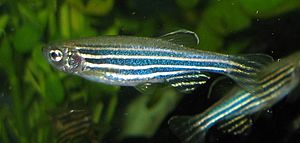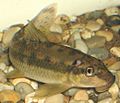Cypriniformes facts for kids

Cypriniformes is a large group of ray-finned fish. This means they have fins supported by bony spines. This group includes many well-known fish like carps and minnows. There are over 320 different types of these fish (called genera) and more than 3,200 different species! These fish are found all over the world, especially in fresh water.
Contents
What are Cypriniformes Fish?
Cypriniformes are a very diverse group of fish. They live in many different freshwater places. You can find them in rivers, lakes, and ponds. Most of them have scales and a special fin on their back. Many species in this group are important for food. Others are popular as aquarium pets.
Key Features of Cypriniformes
These fish share some common features. One important feature is their mouth. Most Cypriniformes have mouths that can extend forward. This helps them to suck up food from the bottom. They also usually have a special set of teeth in their throat. These are called pharyngeal teeth. They use these teeth to grind their food.
Where Do Cypriniformes Live?
Cypriniformes are found on almost every continent. They live in Africa, Europe, and Asia. You can also find them in North America and Central America. They prefer freshwater environments. This includes streams, rivers, and lakes. Some species can live in slightly salty water, but most are strictly freshwater fish.
Different Types of Cypriniformes
The Cypriniformes group is huge. It includes many different families of fish. Some of the most famous families are:
- Carps and Minnows: This is the largest family. It includes common fish like goldfish, koi, and many types of minnows. They are known for their varied sizes and colors.
- Loaches: These fish often live at the bottom of rivers. They have special whiskers, called barbels, around their mouths. These help them find food in the mud.
- Suckers: These fish have thick, fleshy lips. They use their mouths like a vacuum cleaner to suck up food from surfaces.
Important Roles in Ecosystems
Cypriniformes play a big role in their habitats. They are often a food source for larger fish, birds, and mammals. They also help to control algae and insect populations. Some species are herbivores, eating plants. Others are omnivores, eating both plants and small animals.
Conservation of Cypriniformes
Sadly, some Cypriniformes species are in danger. For example, the thicktail chub from North America is now extinct. This means it no longer exists anywhere on Earth. Other species, like the red-tailed black shark, are very rare in the wild. Protecting their habitats is very important. This helps to keep these amazing fish around for the future.
Images for kids
-
A true loach - the spined loach, Cobitis taenia
-
The Chinese algae eater (Gyrinocheilus aymonieri) is one of the sucking loaches, which are distant from other "loaches".
-
Erimyzon sucetta, a small sucker
-
The thicktail chub (Gila crassicauda) is globally extinct since about 1960.
-
Few if any red-tailed black sharks (Epalzeorhynchos bicolor) remain in the wild today.
See also
 In Spanish: Cipriniformes para niños
In Spanish: Cipriniformes para niños







